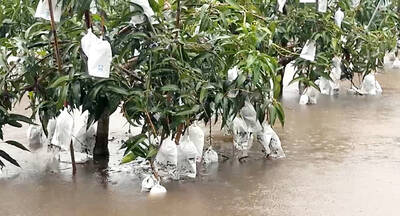A database on biodiversity in Taiwan has compiled records of almost 10 million wildlife sightings, making it the second-largest wildlife index in Asia, with the vast majority of data coming from volunteers, the Council of Agriculture’s Endemic Species Research Institute said.
The Taiwan Biodiversity Network, which was launched in 2007, has recorded 9.87 million animal and plant sightings, Ko Chih-jen (柯智仁), an assistant researcher at the institute, said on Friday, adding that India maintains Asia’s largest database with up to 19 million recorded sightings.
Birds are the most widely tracked animals in the nation, with 7.47 million reported sightings, Ko said.

Photo: Yang Yuan-ting, Taipei Times
They are followed by butterflies and moths, with 410,000 sightings, and frogs, with about 100,000, the database showed.
More than 8.5 million, or 87 percent of the sightings, were submitted by volunteers after the institute began accepting reports from the public in 2017, Ko said.
Seven percent of the sightings came from publicly sponsored projects, while 5 percent are based on museum records, he added.
The remainder, accounting for less than 1 percent, came from scientific research, non-governmental organizations or genetic sequencing projects, Ko said.
The database can help conservationists track changes in the population of various species and contribute to public safety.
For instance, the Centers for Disease Control bases the nationwide distribution of antivenom on the database’s records of poisonous snake sightings, institute director Yang Jia-dong (楊嘉棟) said.
In addition to recording wildlife sightings, the institute also promotes civilian science initiatives and education on topics such as roadkill prevention and wildlife conservation on farmland, he added.

‘NON-RED’: Taiwan and Ireland should work together to foster a values-driven, democratic economic system, leveraging their complementary industries, Lai said President William Lai (賴清德) yesterday expressed hopes for closer ties between Taiwan and Ireland, and that both countries could collaborate to create a values-driven, democracy-centered economic system. He made the remarks while meeting with an Irish cross-party parliamentary delegation visiting Taiwan. The delegation, led by John McGuinness, deputy speaker of the Irish house of representatives, known as the Dail, includes Irish lawmakers Malcolm Byrne, Barry Ward, Ken O’Flynn and Teresa Costello. McGuinness, who chairs the Ireland-Taiwan Parliamentary Friendship Association, is a friend of Taiwan, and under his leadership, the association’s influence has grown over the past few years, Lai said. Ireland is

A saleswoman, surnamed Chen (陳), earlier this month was handed an 18-month prison term for embezzling more than 2,000 pairs of shoes while working at a department store in Tainan. The Tainan District Court convicted Chen of embezzlement in a ruling on July 7, sentencing her to prison for illegally profiting NT$7.32 million (US$248,929) at the expense of her employer. Chen was also given the opportunity to reach a financial settlement, but she declined. Chen was responsible for the sales counter of Nike shoes at Tainan’s Shinkong Mitsukoshi Zhongshan branch, where she had been employed since October 2019. She had previously worked

FINAL COUNTDOWN: About 50,000 attended a pro-recall rally yesterday, while the KMT and the TPP plan to rally against the recall votes today Democracy activists, together with arts and education representatives, yesterday organized a motorcade, while thousands gathered on Ketagalan Boulevard in Taipei in the evening in support of tomorrow’s recall votes. Recall votes for 24 Chinese Nationalist Party (KMT) lawmakers and suspended Hsinchu City mayor Ann Kao (高虹安) are to be held tomorrow, while recall votes for seven other KMT lawmakers are scheduled for Aug. 23. The afternoon motorcade was led by the Spring Breeze Culture and Arts Foundation, the Tyzen Hsiao Foundation and the Friends of Lee Teng-hui Association, and was joined by delegates from the Taiwan Statebuilding Party and the Taiwan Solidarity

TRANSPORT DISRUPTION: More than 100 ferry services were suspended due to rough seas and strong winds, and eight domestic flights were canceled, the ministry said Tropical Storm Wipha intensified slightly yesterday as it passed closest to Taiwan, dumping more than 200mm of rain in Hualien and Taitung counties, the Central Weather Administration (CWA) said. As of 11am, Wipha was about 210km southwest of Cape Oluanpi (鵝鑾鼻) and was moving west-northwest at 27km per hour (kph). The storm carried maximum sustained winds of 101kph and gusts reaching 126kph, with a 150km radius of strong winds, CWA data showed. Wipha’s outer rainbands began sweeping across Taiwan early yesterday, delivering steady rainfall in the east and scattered showers in other regions, forecasters said. More heavy rain was expected, especially in the eastern